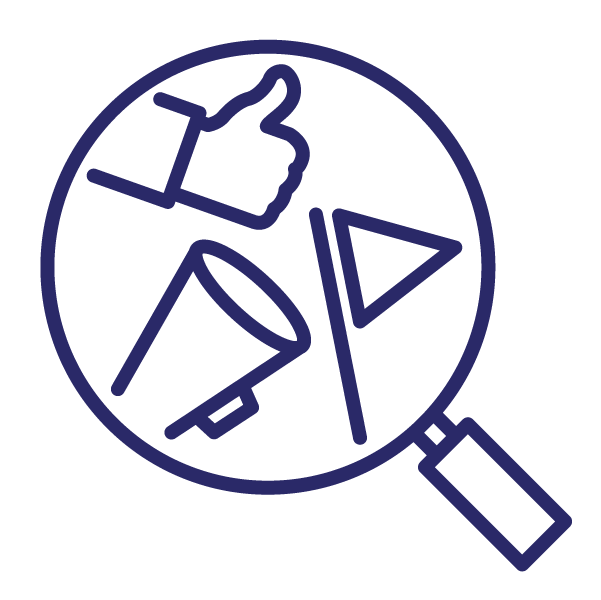
Finding Focus in the Midst of Noise and Distraction
The buzzword being thrown around throughout the COVID period has been “pivot.” We’ve all experienced firsthand the need to make adjustments personally, professionally and/or emotionally at some point in time since March.
Now, in order to keep moving forward in a positive direction, the new buzzword I am suggesting for you is focus. Let’s take a closer look at how an increased focus can help you “move the needle.”

Focus Tip #1: Prioritize Your Time
“Lack of direction, not lack of time, is the problem. We all have twenty-four hour days.”
-Zig Ziglar
In March, many people suddenly found themselves with time on their hands as we were forced to work from home. We were given the gift of time once spent traveling to and from the workplace, allowing us to get started with our day sooner and possibly wrap up at a reasonable time. However, many who were working from home for the first time complained of never being able to “turn it off.” They found it difficult to distinguish work time from personal time, and the two bled together. Since that transition, most have been able to establish a routine that balances work and personal life.
How we choose to spend our time has a huge impact on whether we’re setting ourselves up for success. We all have special knowledge, skills and abilities that have value and are in demand; we must align ourselves with the best place to put them to use. Is it time to revisit your personal and professional goals? Are there commitments you should be reconsidering or removing as a priority?

Focus Tip #2: Uncover and Leverage Internal Motivators
“It’s just not the same without fans in the stands; we have underrated and understated their importance to the game.”
-Tim Kurkjian, ESPN Senior Editor
Athletes at all levels across every sport have had to deal with unprecedented challenges which include stringent COVID test protocols and playing in front of small or no crowds. Fans are what drive every sport. People use the term “home field advantage” to emphasize the importance of having the crowd backing up their team for every pitch, snap, pass or kick. Professional basketball introduced “virtual fans” to their games this season, and major league baseball (MLB) went with the artificial cardboard cutout fan in many of its seats. Many sports teams have chosen to pipe in fake fan crowd noise to give off the semblance of a traditional game setting. College football and the National Football League are allowing small, social distanced crowds to its games, and MLB announced it would be selling a few seats to its final playoff rounds.
In spite of these efforts, the experience has been hollow for some fans, players and coaches. So what can be done about it? How can sports bring the game back to the fans while respecting social distancing and related group dynamics?
Until a solution is found, athletes have had to draw on their own personal motivations and work together as a team to rekindle their passions towards the game and sense of competition that drives them. The Miami Marlins baseball team, hit the hardest by COVID with 18 players testing positive and 61 players being used to get through the season, used virtual group chats to stay close during the shutdown and subsequent struggles. One player, Garrett Cooper, shared this about group chats: “It’s been a thing since we started the year…so we can voice what we want as a team together…to kind of amp us up, each day, each morning, to get ready for that day.”
One can draw the same correlations to the workplace. During the pandemic, virtual interaction has been key to driving communication, collaboration and decision-making. Some organizations have even strengthened their culture as their employees have grown closer personally and professionally by sharing stories and finding new, innovative ways to solve problems. What policies and procedures has your organization revisited during this time? In what ways has your team or department motivated one another to keep moving forward? How have you used this time to grow closer to one another and become more productive?

Focus Tip #3: Be a Change Agent
“The world as we have created it is a process of our thinking. It cannot be changed without changing our thinking.”
-Albert Einstein
Since the beginning of this pandemic, thought leaders have preached the importance of looking at how you do things differently. Those who proactively a) looked at how they conducted business, b) addressed business challenges and c) prepared their teams, departments and organizations to serve their clients and customers more effectively would come out on top as a “new normal” was established. Clearly, having an adaptable, mobile workforce is key to moving forward. Being able to communicate and make decisions using technology when needed is essential.
When looking at Learning Curve Consultants, the focus of our business is providing our clients with end-to-end learning and development solutions to help Unleash Your Talent within the organization. During this time, we have been continuing to identify new and innovative ways to accomplish this virtually without sacrificing the impact of the content or message. The key for us has been to work collaboratively with our clients so there is buy-in, acceptance and excitement from the beginning about what we’re doing to ensure a successful outcome.
How has your thinking changed? Is the way you coach, manage and lead your team different today than it was in March? Has your approach to delivering your product or service to your customers changed? Are you thinking about differentiation in order to stay relevant with your clients? Do you have a compelling story to tell about how you can help your customer “win”?
